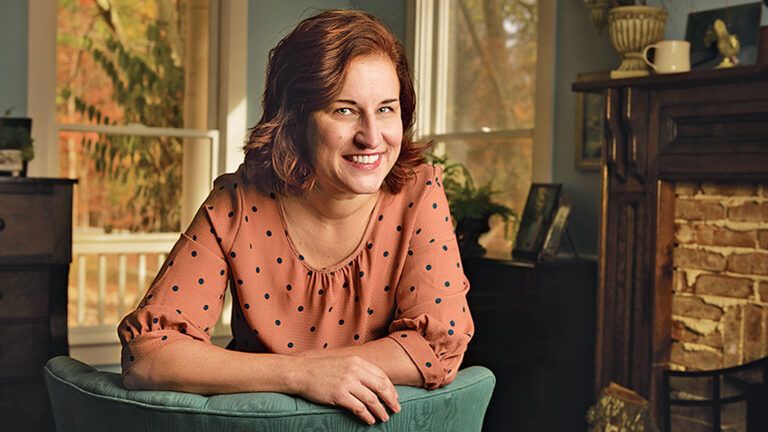It all started with a call from Arkansas State University a couple of years ago. They wanted to buy and restore my dad’s boyhood home in the town of Dyess, about 50 miles from their Jonesboro campus, and turn it into a music-heritage site.
As you can imagine, people often call me about some Johnny Cash project that they hope to get me involved with. I usually say no. But this idea tugged at my heart.
My dad was proud of his roots, the WPA colony where he grew up, and the strong work ethic and faith of the people who lived there. It was a crucial part of his identity. So I said yes.
Soon my husband, John Leventhal, and I were making regular trips to Arkansas and other parts of the Delta. It awoke something in me. I felt like I was experiencing the land and the people more deeply than I had before.
We discovered great stories, and melodies that went with them. The songs John and I wrote came together in my latest album, The River & the Thread. So many of the lyrics have places connected to them. Here are three.
Dyess, Arkansas
Dyess was a planned community, founded in 1934 as part of F.D.R.’s New Deal. Five hundred houses were built and each new homeowner was given about 20 acres to clear and farm. My dad’s family moved to Dyess in 1935, in the darkest days of the Depression. They were desperately poor.
Dad was only three years old. Eventually there would be seven kids crammed into their little cottage, but it was a huge step up for the Cash family. At last they had a home and land they could call their own.
Still, it was an incredibly hard life. Everybody worked in the fields, and the soil wasn’t easy to till.
That corner of northeast Arkansas is called the Sunken Lands because of a series of earthquakes that hit in 1811 and 1812. The ground dropped as much as 50 feet and the Mississippi River flooded it. When the water retreated, the earth was gummy and full of rocks. Gumbo soil was how folks referred to it.
I was close to my grandmother Carrie Cash. She could play any gospel tune on the piano, her fingers running up and down the keyboard, and she was a fabulous cook. But seeing the house where she’d raised seven children gave me a whole new perspective on how tough it must have been.
Picking cotton all day in the hot sun and then working just as hard at home, cooking and cleaning for her family, with a demanding husband. “The children cry, the work never ends,” I wrote in a lyric about her. “Who’ll hold her hand in the sunken lands?”
We’ve had several benefit concerts in Jonesboro to raise money for the restoration of the site (the house will open this spring for visitors, the rooms looking just like they did in the thirties).
The most poignant concert was the one where my dad’s longtime bass player, Marshall Grant, came down to join us. Marshall was like a second father to me, and knew all the stories about the early years of my dad’s career, good and bad.
He played at the rehearsal, but that night he had an aneurysm that led to his death. I wrote in a song how he worked to the last, like the dedicated musician he was: “As the daylight fades away, / I’ll make one last rehearsal with one foot in the grave.” Hard work was part of his heritage too.
Florence, Alabama
Originally I went to Florence for sewing lessons. My friend Natalie Chanin lives there and started a business making beautiful clothes, all hand-sewn by local women. It meant a lot to Natalie to bring jobs to her community.
I was in her studio, struggling to pull a thread through some fabric when she said, “You have to learn to love the thread.” I know she meant it as practical advice, but it seemed an apt metaphor for the thread of life, one that came to be part of a song lyric.
Natalie took John and me a little ways outside town to see a wall a man named Tom Hendrix has been building for 25 years. By now it stretches over a mile long and is made up of stones from all 50 states and some 127 countries.
Tom was there when we dropped by. He explained that he was building the wall as a memorial to his great-greatgrandmother, Te-lah-nay. A Yuchi Indian, she had been driven from her home along the Tennessee River and forced to walk the infamous Trail of Tears to Oklahoma.
She couldn’t bear life on the reservation. She longed for her beloved river, whose flowing waters sounded like a woman singing. After one winter in Oklahoma, Te-lah-nay began the long trek home.
It took her five years to get back to the Singing River, as her people called it, and Tom is determined to lay one stone in the wall for each step she took.
The wall is on several lists of sacred places in Alabama, he says, and no wonder. At one end, there’s this little prayer circle. I sat down on a bench in the middle, rested my hands on the weathered stone and closed my eyes to meditate.
Wow, it was powerful. I felt so small and yet at the same time so connected to something much bigger than me.
Tallahatchie Bridge
Bobbie Gentry’s hit song “Ode to Billie Joe” made the Tallahatchie Bridge outside Greenwood, Mississippi, famous. But I hadn’t realized how rich in history the area is.
John and I were driving on Money Road heading down to Greenwood when we saw a marker that said Robert Johnson’s grave site. Now, for any musician steeped in the blues, Robert Johnson is a name to be reckoned with, though he died at just 27, leaving precious few recordings.
He was an extraordinary singer, guitarist and songwriter. Some say he invented the blues. Because his skills seemed to come out of nowhere, a legend developed that he’d sold his soul to the devil in exchange. There’s no validity whatsoever to the story, but it says a lot about his otherworldly talent.
We got out of the car and found his gravestone under a tree in the Little Zion Missionary Baptist Church cemetery. The wind was whispering through the bare branches. I couldn’t help wondering what kind of songs he would’ve written if he’d lived longer.
We drove four miles to another landmark a mere 300 feet from the bridge, a run-down shed that was the grocery store where in 1955, a 14-year-old African-American boy, Emmett Till, supposedly whistled at a white woman.
Two outraged relatives of hers seized him, tortured him and shot him, then threw his body into the Tallahatchie River. His mother insisted on an open-casket funeral so the world could see the brutality that had been visited on her son.
Emmett Till’s murder became a pivotal event in the civilrights movement.
What struck me was how lonely these landmarks were. We didn’t see anyone else at the windblown cemetery, the run-down store or the Tallahatchie Bridge. These sites are a part of our musical heritage, our spiritual heritage, yet it was as though time had forgotten them.
I’m grateful my dad’s boyhood home is being restored, but we’d seen other places worth preserving too, places that inspired another lyric: “I’m dreaming about the Tallahatchie Bridge, a thousand miles from where we live…”
Music can take you places far beyond the familiar. But what I discovered on my trips down South was how places themselves have their own music. Wander through an old house. Sit by a sacred wall. Walk by flowing waters. Close your eyes and listen. What songs do you hear?
Download your FREE ebook, True Inspirational Stories: 9 Real Life Stories of Hope & Faith





